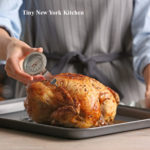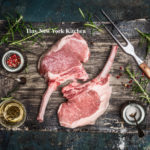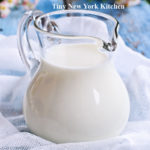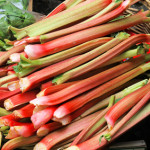When cooking meats, it’s important to know the various temperatures.
Beef: Rare 120F to 125F (45C to 50C), Medium Rare 130F to 135F (55C t 60C), Medium 140F to 145F (60C to 65C), Medium-Well 150F to 155F (65C to 70C), Well Done 160F and above (70C and above)
Pork: Medium Rare 145F (63C), Medium 160F (70C), Well Done 170F (76C)
Poultry: Well Done 165F (75C)
Lamb: Medium Rare 145F (65C), Medium 160F (70C), Well Done 170F (76C)
Fish: Well Done 145F (65C)
To find out what temperature your meat is at, remove food from oven, turn on the digital display by pressing the on/off button. Select F/C. Insert thermometer in the thickest part of the meat, immersing the stem at least 1 inch, but not to contact with bone, fat or gristle and wait for the temperature to stabilize.
The digital display will automatically give you the cooking temperature. If additional cooking time is needed, remove the thermometer from the food and return the dish to the oven.
“Work With What You Got!”
©Tiny New York Kitchen © 2021 All Rights Reserved
Look for thicker pork chops (about 1/2-inch-thick) for roasting as they are less likely to dry out in the oven. Save cutlets and thin cut chops for searing and stir fries.
“Work With What You Got!”
©Tiny New York Kitchen © 2021 All Rights Reserved
Roasting refers to proteins and vegetables cooked mostly at high temperatures in the oven. Baking uses a lower temperature to cook breads, baked goods, and casseroles.
Roasting makes any vegetable taste better. It brings out their flavor, caramelizes their natural sugars, and adds crunch. If your family doesn’t love certain vegetables like broccoli or Brussels sprouts, roasting is a great way to change their mind. Double what you’re roasting and then turn extra servings into quick meals later in the week. Cooking a little extra with one meal lets you make the most of value-sized packages of proteins and other store sales. With leftover already planned, you won’t need to lean on takeout.
Why we love to roast:
It’s Affordable! Inexpensive ingredients are tastiest when roasted. Root vegetables are browned and crisp, tomatoes and grapes are extra juicy and sweet, and tough cuts of beef are fall-apart tender. You also don’t need any special equipment to roast.
Roasting Is Healthful! Roasted foods need very little fat to cook compared to frying or sautéing. Roasting also intensifies flavors without added salt, sugar, or other ingredients.
It’s Easy! Roasted foods need little prep before they cook. And once the oven door closes, you can walk away. Fewer pans and utensils are needed, making cleanup easier too.
Essential Tools For Roasting:
Rimmed Sheet Pan: The rim keeps vegetables from falling off the sides and catches any juices from meats and fish.
Oven-Save Skillet: Go from stovetop to oven and back. Sear meats before roasting or make a pan sauce with the meat drippings after roasting.
Roasting Pan: Best for large roasts, hams, and turkeys. An inner rack lifts the meat so it can brown and crisp underneath.
Parchment Paper: Line pans to keep foods from burning and sticking, then toss for easy cleanup. If roasting at a higher temp or broiling use foil.
Metal Tongs: Flip and stir foods on a hot pan with ease. Look for tongs with a heat resistant grip.
Silicone Brush: Brush on a sticky glaze or baste foods with sauce. The silicone bristles are easy to clean.
Tips For Sheet Pan Roasting:
Jump Start Browning by preheating your sheet pan before adding vegetables.
Pat foods very dry with paper towels so the outside browns while the inside cooks through.
Cut foods to the same size and thickness so smaller pieces don’t burn.
Space out foods on the sheet pan so they have room to crisp and brown.
Let sheet pans cool before rinsing to keep the metal from warping.
©Tiny New York Kitchen © 2021 All Rights Reserved
Buttermilk is a fermented dairy drink that was traditionally the liquid left behind after churning butter out of cultured cream. Today, most modern buttermilk is cultured. Cultured buttermilk was first commercially introduced in the US in the 1920s. Commercially produced buttermilk is milk that has been pasteurized, homogenized, and then inoculated with a culture of Lactococcus lactis to simulate the naturally occurring bacteria in the old-fashioned buttermilk. The tartness of cultured buttermilk is primarily due to lactic acid produced by lactic acid bacteria while fermenting lactose, the primary sugar in milk.
Condensed buttermilk and dried buttermilk are very important in the food industry. Liquid buttermilk is used primarily in the commercial preparation of baked goods and cheese. Buttermilk solids are used in ice cream manufacturing as well as being added to pancake mixes to make buttermilk pancakes.
Buttermilk reacts with the baking soda and powder to give quick breads their rise and tender crumb. The reaction is best at the beginning, you’ll want to get the loaf in the oven right after mixing the wet and dry ingredients. Buttermilk can also be used in marinating meats, especially chicken and pork, because the lactic acid helps to tenderize, retain moisture, and allows added flavors to permeate the meats.
©Tiny New York Kitchen © 2021 All Rights Reserved
Lucky Foods For New Year’s Day
This New Year’s make a resolution to bring yourself a heaping helping of good luck. It’s as easy as just making dinner.
In cultures around the world, the new year is celebrated with particular foods and recipes thought to bring good fortune. Symbolizing wealth, long life, and prosperity, lucky foods are an auspicious and delicious way to celebrate the holiday and welcome good things in the coming year.
Pork & Sauerkraut
Tender braised pork, along with other forms of pork (like sausages and roasts) is a symbol of abundance in Celtic and Chinese cultures, and is popular amongst the Pennsylvania Dutch on New Year’s Day. Paired with the cabbage in sauerkraut, a Chinese symbol of wealth and prosperity, this easy braise with apples and onions is one tasty pot of good luck.
Black Eyed Peas, Greens & Cornbread
Traditionally eaten in the South on New Year’s Day, this trifecta of ingredients represents three different types of money. Leafy greens represent dollar bills, the round peas symbolize coins and cornbread is the color of gold.
Grapes
According to Spanish lore, eating 12 grapes as the clock chimes midnight on New Year’s Eve will bring you 12 months of good luck. Incorporate this tasty tradition by adding grapes to your holiday cheese board or dessert platter. Or try a delicious side dish with savory sautéed Brussels sprouts, grapes, and crunchy walnuts.
Pomegranates
In Greece, smashing a pomegranate on the floor to release the seeds is a surefire way to bring good luck. The seeds represent abundance and fertility. The more seeds you see, the luckier you’ll be. Instead of smashing, sprinkle that good fortune over peak season oranges, mixed greens, and prosciutto for a colorful celebration of a salad.
Fish
Fish are thought to represent progress and abundance because they constantly swim forward and group together in schools. In Czech culture, the scales of the fish are considered lucky because they resemble silver coins and if you carry a silver coin in your wallet it is said that your money will never run out. Celebrate the new year abundantly with a fish dish that everyone will enjoy.
Noodles
No Chinese New Year, Lunar New Year, celebration is complete without a bowl of noodles. Symbolizing longevity and health, noodles are always left whole. Breaking or cutting a long strand of noodles is considered bad luck. Nourish a long life with a longevity noodles dish.
Cake
Ring shaped cakes, like Bundt cakes, are a sweet way to celebrate coming full circle from the previous year. In cultures around the Mediterranean, a coin is baked into the cake and thought to bring wealth and good fortune to the lucky recipient who finds it. Bake a delicious ring-shaped cake and be sure to warn your guests if you decide to bake it with a coin hidden inside.
©Tiny New York Kitchen © 2020 All Rights Reserved
Grilled pineapple is so very versatile because you can use it for savory or sweet, hot or cold dishes. Grill over indirect heat and the sugars in the pineapple concentrate bringing out a sweet and meaty fruit that is ideal for endless summer recipes.
6 Ways To Use Grilled Pineapple
Slice and serve with grilled pork or fish.
Cut into chunks and toss with salt and lime juice for a smoky fruit salad.
Muddle and use as the base for a sweet-savory cocktail.
Dice and mix with chopped cilantro and chiles for salsa.
Purée and spoon over vanilla ice cream or good Greek yogurt.
Top with ice cream or sorbet.
“Work With What You Got!”
© Victoria Hart Glavin Tiny New York Kitchen © 2017 All Rights Reserved
Generally animal products are higher in fat than plant foods, but it’s not necessary to cut out all meat and dairy products to keep your fat intake reasonable. Low-fat dairy foods, lean and well trimmed meat, and skinless poultry provide the same amounts of vitamins and minerals as their fattier counterparts. Skinless poultry, fish, dry beans, and split peas are the “slimmest” foods in this category. By removing the skin from poultry, you reduce the fat by almost one half. Most seafood is low in fat and also contains beneficial omega-3 oils, which have been linked to lowering blood cholesterol. Dry beans also provide the body with fiber, which is necessary for digestion.
You can enjoy red meat if you choose lean cuts and trim away all the visible fat (marbled fat cannot be trimmed away). Here are some good choices:
*Beef eye round, top round, tenderloin, top sirloin, flank steak, top loin, and ground beef. Choose ground sirloin; it’s 90 to 93 percent lean.
*Veal cutlets (from the leg) and loin chops.
*Pork tenderloin, boneless top loin roast, loin chops, and boneless sirloin chops.
*Lamb, boneless leg (shank portions), loin roast, loin chops, and leg cubes for kabobs.
Here are some suggestions to make trimming excess fat from your diet easier:
*Choose lean cuts of meat and trim off all the visible fat before cooking. Remove skin from poultry before or after cooking.
*Broil meat on a rack so the fat can drop away.
*Substitute ground chicken or ground turkey for ground beef. Look for ground turkey breast or chicken breast; otherwise, it may contain skin and therefore have as much fat as ground beef.
*Substitute protein-packed dried legumes, like beans and lentils, for meat in casseroles.
*Chill soups and stews overnight so you can remove all the hardened fat from the surface.
*Be skimpy with fat. Use nonstick pans and nonstick cooking spray, or sauté in a small amount of broth or water. Don’t just pour oil into a skillet; it’s easy to add too much. Measure or use a pastry brush to coat pans with a thin layer of oil. When baking, coat pans with a spritz of nonstick cooking spray instead of oils or fats. Kitchenware shops carry oil sprayers you can fill with your favorite oil.
*Experiment with low fat or skim milk, low fat sour cream and cheese, and nonfat yogurt. They provide the same amounts of calcium and protein as the whole milk varieties, but with less fat or none at all.
*When making dips, substitute nonfat plain yogurt for sour cream.
*Use fresh herbs and zesty seasonings literally.
*Choose angel food cake instead of pound cake, especially when making cake-based desserts like trifle.
*To reduce fat and cholesterol, you can substitute 2 egg whites for 1 whole egg in recipes, but don’t substitute egg whites for all the whole eggs when baking. The dessert will have better texture and flavor if you retain a cold or two.
*Replace sour cream with buttermilk or yogurt in recipes for baked goods.
“Work With What You Got!”
© Victoria Hart Glavin Tiny New York Kitchen © 2017 All Rights Reserved
Pantry & Freezer Staples
How long do pantry and freezer staples last? Staple items are known for their long shelf life, but they don’t stay fresh forever! Use this handy list to determine how long you should keep them on hand.
Freezer
Hamburger & Stew Meats: Shelf Life: 1 to 2 Days Storage: 3 to 4 Months
Ground Turkey, Veal, Pork, Lamb: Shelf Life: 1 to 2 Days Storage: 3 to 4 Months
Bacon: Shelf Life: 7 Days Storage: 1 Month
Sausage (Raw From Pork, Beef, Chicken or Turkey): Shelf Life: 1 to 2 Days Storage: 1 to 2 Months
Fresh Steaks: Shelf Life: 3 to 5 Days Storage: 6 to 12 Months
Fresh Roasts: Shelf Life: 3 to 5 Days Storage: 4 to 12 Months
Chicken or Turkey (Whole): Shelf Life: 1 to 2 Days Storage: 1 Year
Chicken or Turkey (Cut Up): Shelf Life: 1 to 2 Days Storage: 9 Months
Lean Fish: Shelf Life: 1 to 2 Days Storage: 6 Months
Fatty Fish: Shelf Life: 1 to 2 Days Storage: 2 to 3 Months
Fresh Shrimp, Scallops, Crawfish, Squid: Shelf Life: 1 to 2 Days Storage 3 to 6 Months
Pantry
Baking Powder: Shelf Life: 18 Months Storage: Keep In Dry Place In Airtight Container
Beans (Dried & Uncooked): Shelf Life: 1 Year Storage: Store In Cool & Dry Place
Chocolate (Semisweet & Unsweetened): Shelf Life: 18 Months Storage: Keep In Cool Place
Cocoa: Shelf Life: 1 Year Storage: Keep In Cool Place
Cornstarch: Shelf Life: 18 Months Storage: Store In Airtight Container
Flour (White or Whole Wheat): Shelf Life: 6 to 8 Months Storage: Store In Airtight Container or Freeze To Extend Shelf Life
Nuts (In Shell & Unopened): Shelf Life: 4 Months Storage: Freeze to Extend Shelf Life
Spices & Herbs (Ground): Shelf Life: 6 Months Storage: Store in Airtight Containers In Dry Areas Away From Sunlight & Heat. Before Using, Check Aroma – If Faint Replace.
Sugar (Brown): Shelf Life: 4 Months Storage: Store in Airtight Container
Sugar (Confectioners’): Shelf Life: 18 Months Storage: Store in Airtight Container
Sugar (Granulated): Shelf Life: 2 Years Storage: Store in Airtight Container
Vinegar (Unopened): Shelf Life: 2 Years
“Work With What You Got!”
© Victoria Hart Glavin Tiny New York Kitchen © 2016 All Rights Reserved















